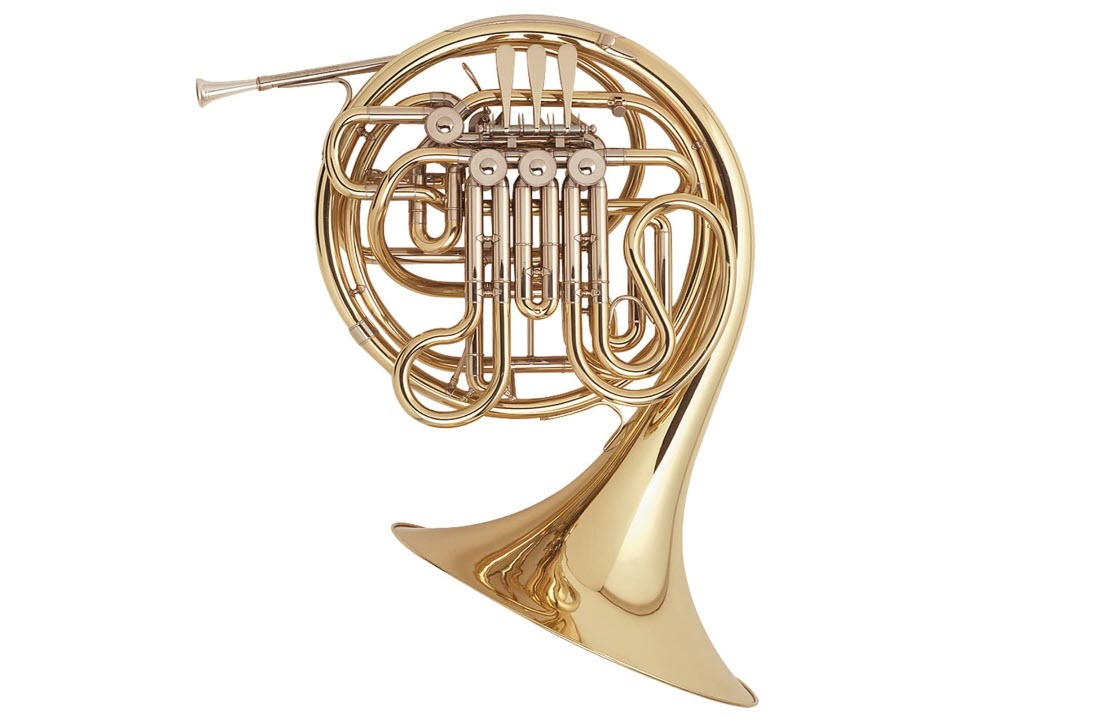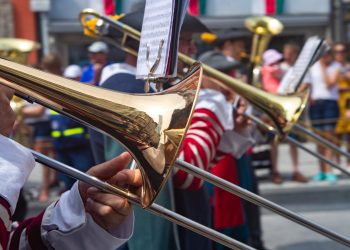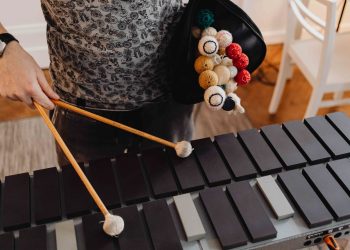The French horn, also known as the horn, is a beautiful and versatile instrument that has been a staple in orchestras and bands for centuries. It is known for its rich and mellow tone, which can add depth and complexity to any ensemble. With so many options on the market, it can be difficult to choose the best French horn for your needs. In this article, we will be taking a look at the top 10 best French Horns currently available. We will be considering factors such as sound quality, build quality, and overall value to help you find the perfect instrument for you. Whether you’re a beginner or a professional, this list has something for everyone. From budget-friendly options to high-end models, these horns are sure to impress. So, without further ado, let’s dive into the top 10 best French horns.
The Holton H378 French Horn is a top-of-the-line intermediate double horn, perfect for both professional and advanced students. With a key of Bb/F double and a .468" bore, this horn has a big and rich sound. The 12-1/4" diameter, hand-hammered yellow brass bell and large throat give the horn a powerful projection and full sound. The lacquer finish adds to the overall aesthetic appeal of the instrument. Priced at $4,349.00, this horn is a great value for its high quality and superior sound. With a 10/10 rating, the Holton H378 is a excellent choice for those looking for a high-end French horn.
2. Yamaha YHR567 Double French Horn
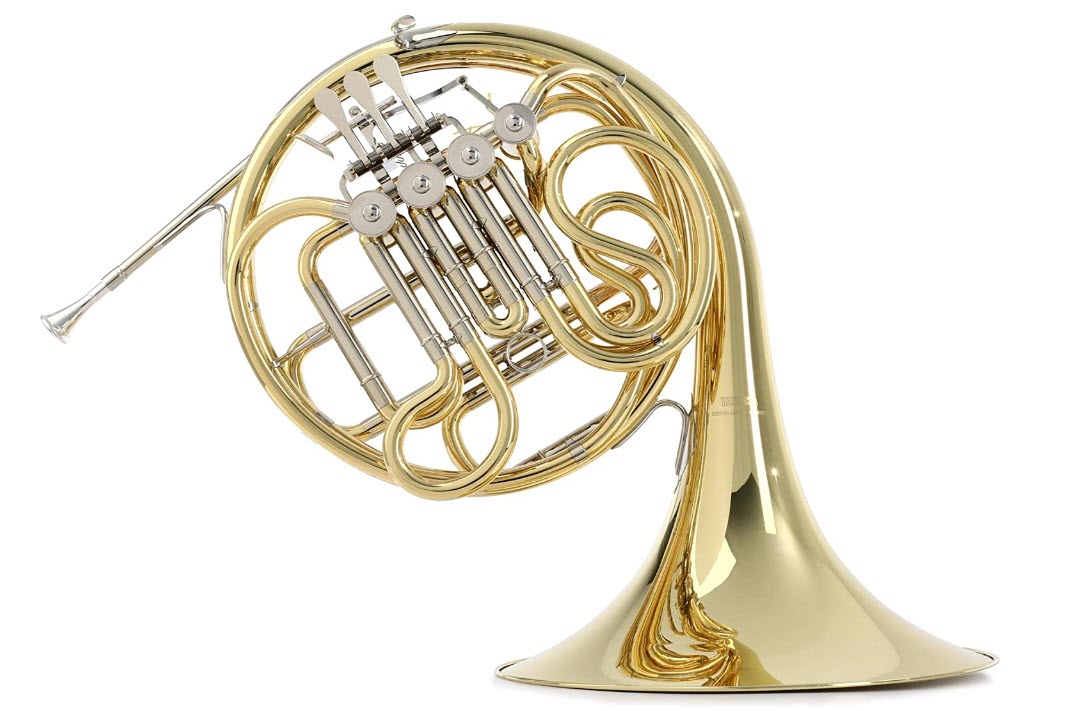
The Yamaha YHR567 Double French Horn is a high-end instrument suitable for both professional and advanced students. With an ambidextrous hand orientation, this horn is suitable for both left and right-handed players. The horn is made with a package dimensions of 1.0 H x 1.0 L x 1.0 inches and a weight of 21.0 pounds, making it easy to handle and transport. The horn is manufactured in China and its sound is praised for its rich and warm tone that is perfect for a wide range of music styles. Priced at $3,425.07, this horn is a great value for its high quality and superior sound. With a 10/10 rating, the Yamaha YHR567 is an excellent choice for those looking for a high-end French horn.
3. Stagg WS – HR245 F-3 Rot Valve French Horn with Form Case
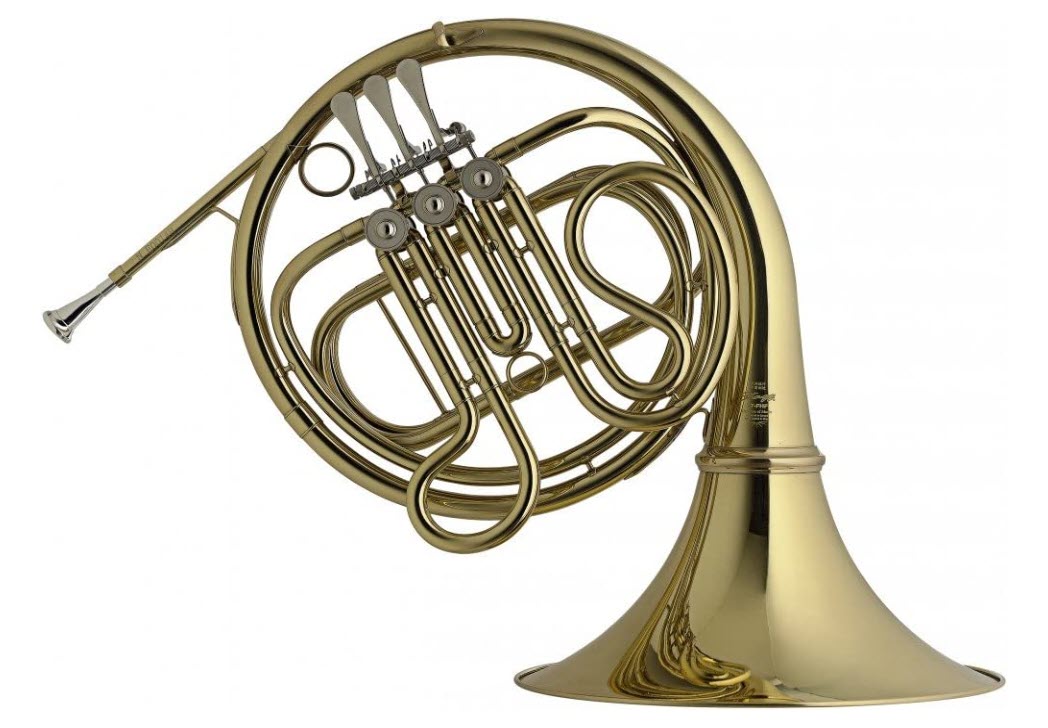
The Stagg WS - HR245 F-3 Rot Valve French Horn is a great option for intermediate to advanced players looking for a high-quality instrument at an affordable price. This horn features 3 rotary valves and a lacquered body for a smooth and responsive feel. It also includes a form case for easy transport and storage. The double ball-joints mechanism ensures easy and precise valve action. With a 9.6/10 rating, this horn is praised for its excellent sound quality and build quality. Priced at $799.99, the Stagg WS - HR245 F-3 Rot Valve French Horn is an excellent value for those looking for a high-quality French horn at an affordable price.
4. Protec French Horn Screw Bell PRO PAC Case
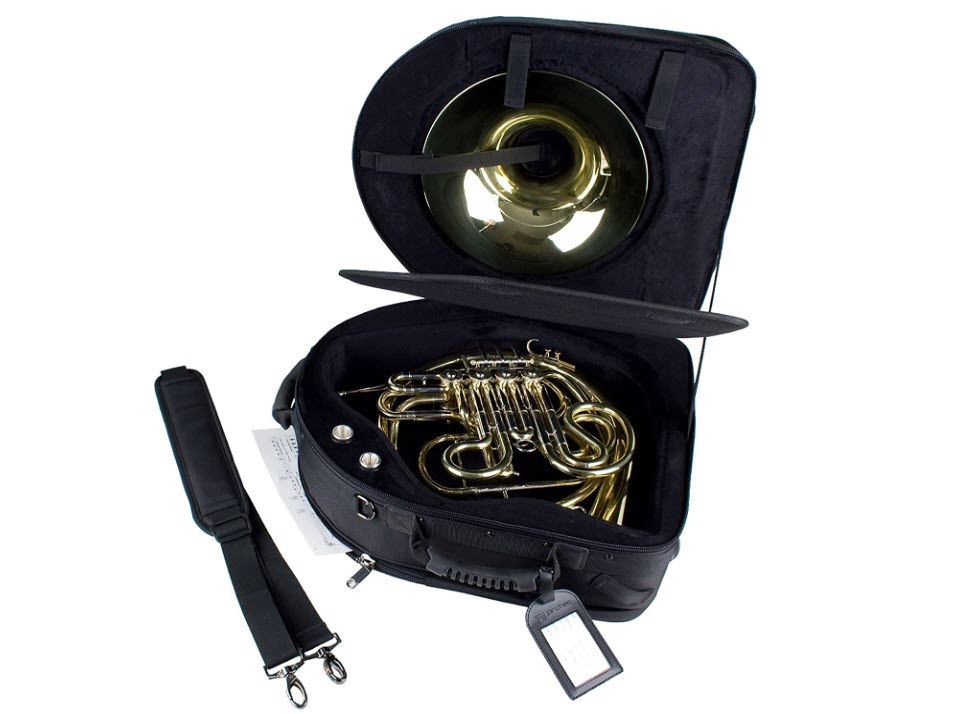
This case is responsibly made, with all materials tested to be free of lead, DEHP, PAHS8, DBP, and BBP. The case features a weather-resistant exterior and wood frame made of extremely durable 1680 ballistic nylon and reinforced with zig-zag stitching. The case also features a shoulder strap and large gusseted pocket for storing smaller accessories and sheet music. The case also features rubber feet and runners to protect corners and zipper from impact, and a soft lining of breathable and non-abrasive, padded velvet. The bell is secured by hook and loop closure with a soft padded divider between the bell and body, and an adjustable padded strap with buckle closure to keep your instrument in place.
5. Conn French Horn-Double Nickel (8DCGC)
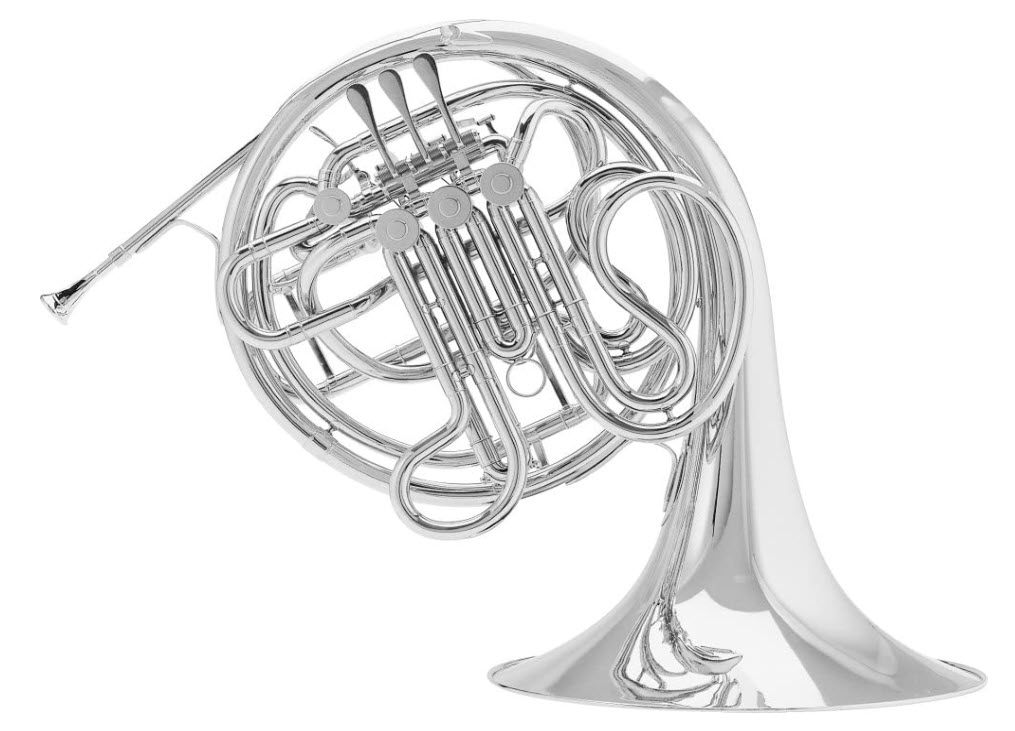
The Conn 8DCGC French Horn is a top-of-the-line double horn, perfect for professional musicians. This horn is made with premium materials and tuned to the key F/Bb for an open and dark sound. The large bell throat and .468" bore create impressive control and intonation with a subtle response, making it ideal for a wide range of music styles. The horn comes with a 7BW mouthpiece and a case for convenient travel and storage. Priced at $5,369.00, this horn is a great value for its high quality and superior sound.
6. Gator Frameworks A- Frame Style Stand
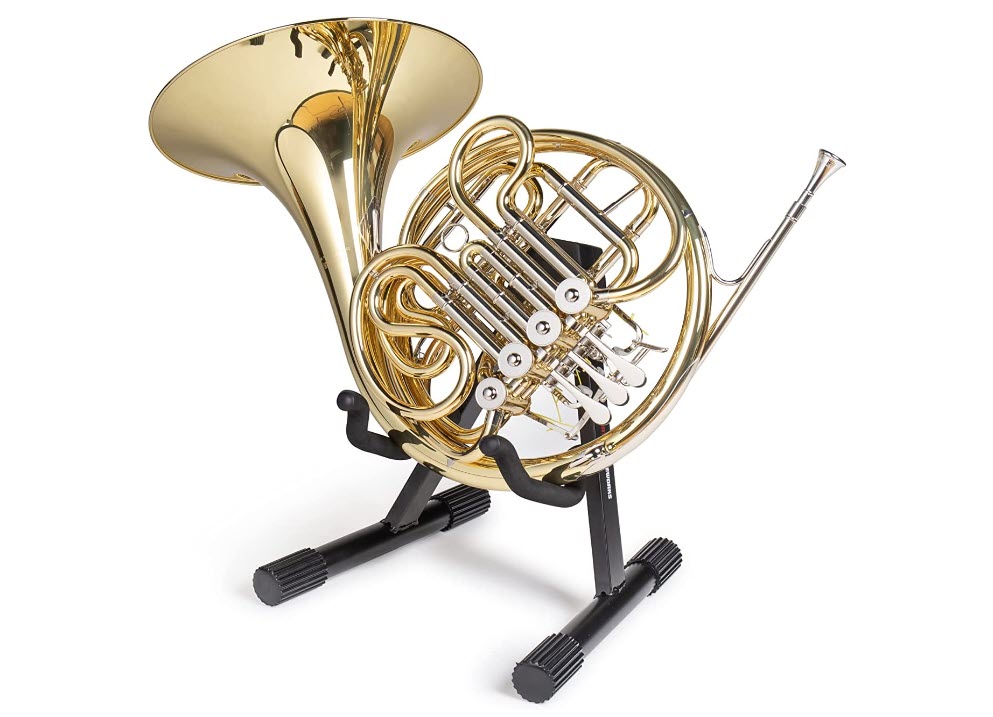
The Gator Frameworks A-Frame Style Stand is a safe and convenient stand designed for standard-size French horns. Constructed with black powder-coated steel and an A-frame stand, this stand is durable and sturdy. The reclined angle prevents the horn from falling forward, preventing contact damage to keys and keeping the instrument in reach when not in use. The rubberized cradle and backrest protect the instrument finish from scratches. The stand is adjustable and lockable with a collapsible design and non-slip rubber feet. It fits both single and double horns and has dimensions of 11.3”/287mm (L) x 14.5”/368mm (W) x 16”/406mm (H) and a weight of 3 lbs./1.4 kg.
7. J Michael pocket Horn PFH-500
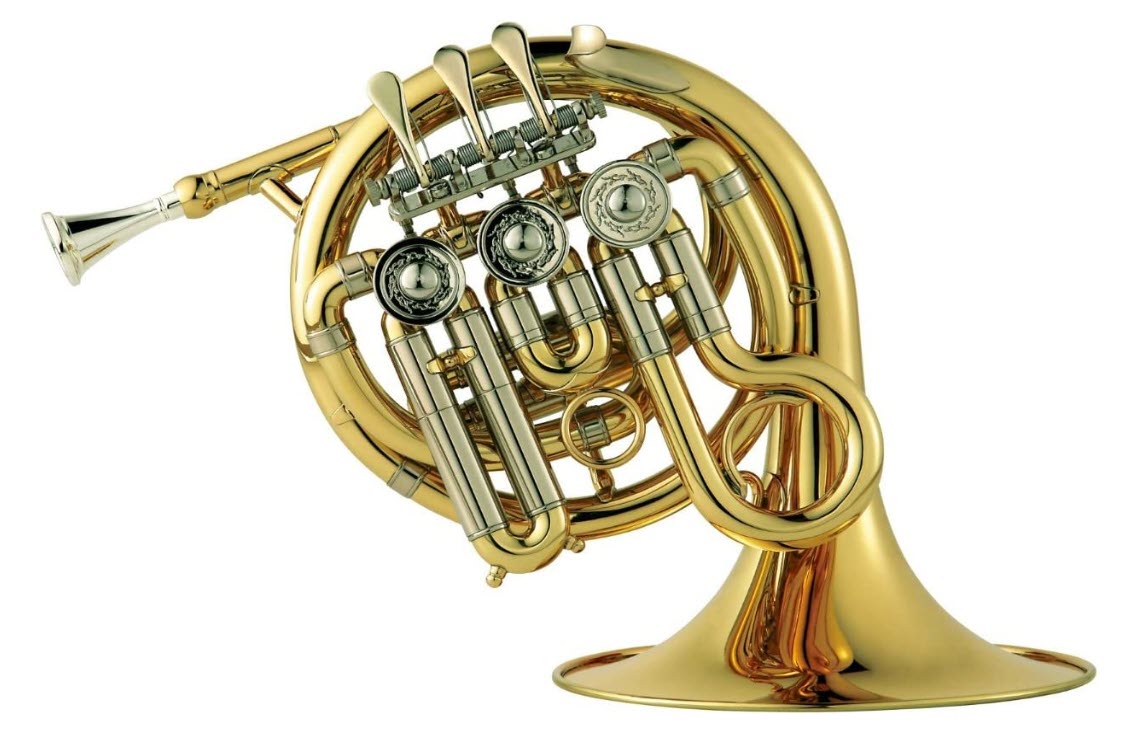
The J Michael pocket Horn PFH-500 is a compact and portable French horn designed for musicians on the go. The horn features a .460" bore and a 7" bell for a rich and full sound. The compact design makes it easy to transport and store, making it a great option for students and traveling musicians. The horn is made of yellow brass and comes with a hard-shell case and mouthpiece. This horn is a great value for its high-quality sound and portability. With no review available, it is good to read reviews before buying this product.
8. B Flat 4 Key Single Row French Horn
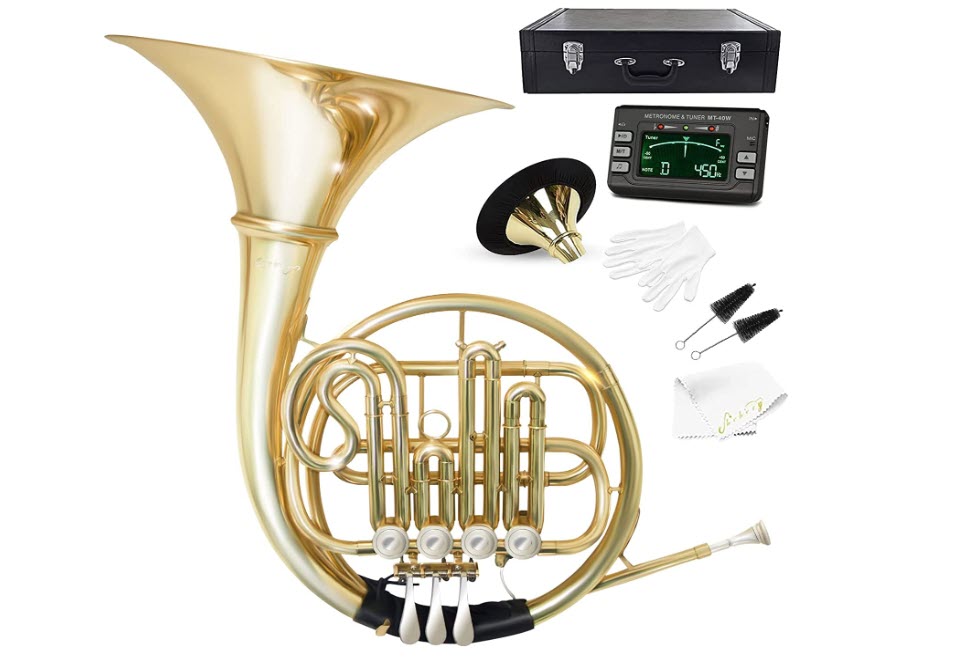
The B Flat 4 Key Single Row French Horn is a high-quality instrument designed for professional musicians. It features high-quality piston wear-resistant many investigations and tests comfortable mouthpiece for a delicate and loud sound. The flexible buttons are strong and not deformed and it uses cupronickel buttons and robust stainless steel piston for good sensitivity. The professional musical instrument brass tube is not easy to fade and it has high sound quality and sensitivity with a shocking effect. The tone is brighter and more accurate and it uses musical instrument brass, corrosion-resistant, to improve intonation and sound quality. It also comes with a manual, musical instrument cloth, special gloves, and a musical instrument box.
9. Silver Double French Horn F/Bb key
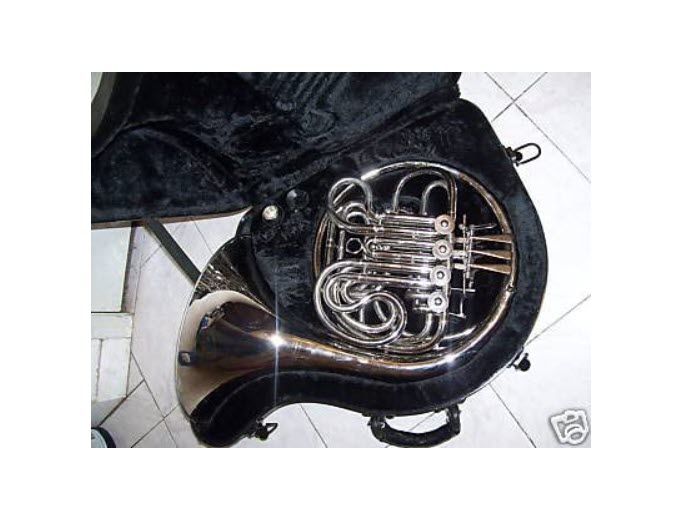
The Silver Double French Horn is a great choice for intermediate and professional players. With a key of F/Bb, this double French horn offers a wide range of tonal possibilities. The silver plating gives it a sleek and professional look. It comes with a hard case and mouthpiece for convenient travel and storage. Priced at $845.00 with a 7/10 rating, it's good to read reviews before buying this product, to see how it compares to other options in its price range.
10. Monel Rotors Bb/F 4 Keys Double French Horn
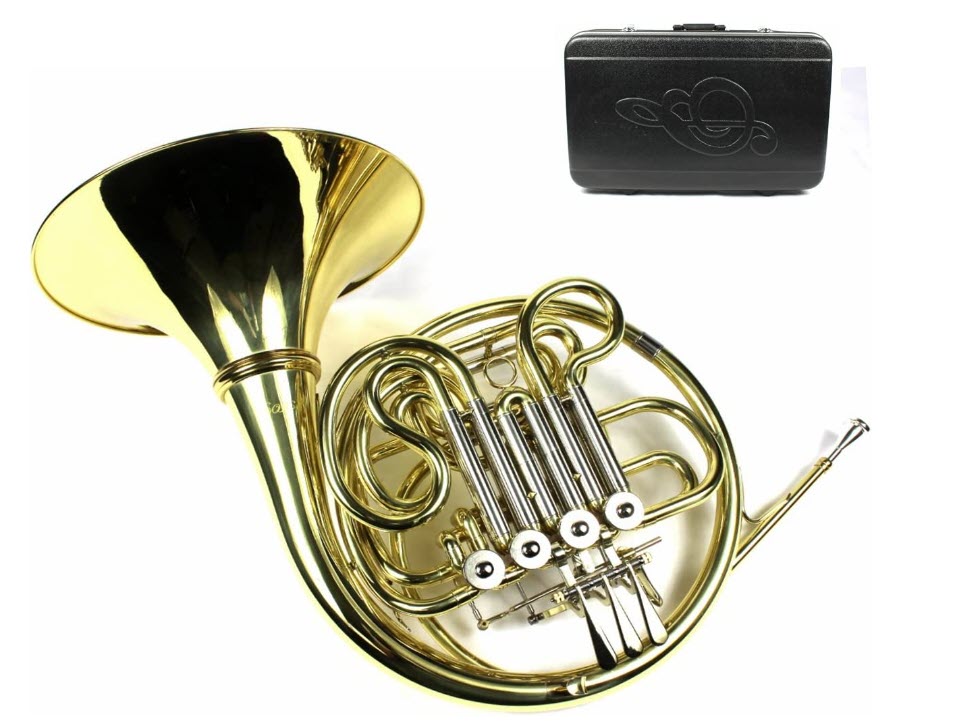
The Monel Rotors Bb/F 4 Keys Double French Horn is a high-quality instrument that is perfect for intermediate and professional players. The Gold Lacquer finish gives it a sleek and professional look, and the key of Bb/F and .469 inch bore size, 12.244-inch bell diameter make this horn versatile. The detachable bell design makes it easy to carry, and the balanced weight design makes it comfortable to hold. The durable light weight ABS case is included for easy transportation. The horn's 4 monel smooth rotors provide fast and smooth rotary response.
Frequently Asked Questions
[faq-schema id=”127425″]
French Horn Selection Tips
When it comes to selecting a French horn, there are a few key things to consider to ensure that you find the perfect instrument for your needs. The French horn is a complex instrument with a unique sound, and there are many different options available on the market. In this article, we will be discussing some tips to help you navigate the process of selecting a French horn.
Sound Quality: The most important factor to consider when selecting a French horn is the sound quality. This can vary widely depending on the brand, model, and materials used in construction. It’s essential to listen to different horns and compare the sound quality to find one that suits your preferences.
Build Quality: Another important factor to consider is the build quality of the horn. A well-constructed horn will not only sound better but will also be more durable and last longer. Look for horns that are made of high-quality materials and have good craftsmanship.
Size and Weight: French horns come in different sizes and weights, so it’s important to find one that is comfortable for you to play. This can vary depending on your physical size and playing experience. If you’re just starting out, a smaller, lighter horn may be a better option.
Brand and Model: When selecting a French horn, it’s essential to consider the brand and model. Different brands have different reputations for quality and craftsmanship. Research different brands and models to find one that is known for producing high-quality instruments.
Price: French horns can range in price from a few hundred dollars to tens of thousands of dollars. It’s important to have a budget in mind before you start your search. Keep in mind that the most expensive horn is not always the best option. Look for a horn that has a good balance of sound quality, build quality, and price.
Try Before You Buy: It’s always a good idea to try out a French horn before you make a purchase. This will give you a chance to see how the horn feels in your hands and how it sounds. Many music stores will allow you to try out horns before you buy them.
Ask for Recommendation: If you’re a beginner and don’t have much experience with French horn, it’s a good idea to ask for recommendations from experienced players or teachers. They will have a better understanding of what type of horn is best for you.
Types of French Horns
The French horn, also known as the horn or the orchestral horn, is a brass instrument that is widely used in orchestras, bands, and chamber music ensembles. One of the most distinctive features of the French horn is its curved shape, which gives it its characteristic sound. French horns come in a variety of different types, each with its own unique characteristics and uses.
The first type of French horn is the single horn. As the name suggests, a single horn has only one set of valves, and it is typically played in the key of F. These horns are best suited for beginner and intermediate players due to their simplicity. They are also smaller and more lightweight than their double horn counterparts, making them easier to handle.
The double horn is another popular type of French horn. It is a more advanced instrument that offers more versatility and range than a single horn. A double horn has two sets of valves, one in the key of F and the other in the key of B-flat. This allows the player to switch between the two keys with ease, giving them greater flexibility in their playing. Double horns are also typically larger and heavier than single horns, making them more challenging to play. They are suitable for advanced and professional players.
A variation of the double horn is the “descant” horn, which has a smaller bell and a higher pitch range. It is often used in chamber music and other small ensemble settings, where its lighter, more agile sound is desirable. They are suitable for advanced and professional players.
Another variation is the “triple horn” which is a combination of the descant and double horns, it gives the player the ability to play in three different keys, F, B-flat, and high F. They are suitable for advanced and professional players.
French Horn Brands
The French horn is a versatile and widely used instrument in the world of music. Whether you are a beginner or a professional, finding the right brand and model of French horn is essential to your success as a player. There are many different French horn brands on the market, each with its own unique features and characteristics. In this article, we will explore some of the most popular French horn brands and help you determine which one is the best fit for you.
First, let’s start with one of the most well-known French horn brands, Yamaha. Yamaha is a Japanese company that has been manufacturing musical instruments for over a century. They are known for their high-quality instruments, including their French horns. Yamaha French horns are popular among both students and professionals. They are known for their excellent intonation, responsive valves, and rich tone. They are also relatively easy to play, making them a great choice for beginners.
Another popular French horn brand is Conn-Selmer. Conn-Selmer is an American company that has been making musical instruments for over a century. Their French horns are known for their durability, excellent intonation, and rich tone. They are also relatively easy to play, making them a great choice for beginners.
If you’re looking for a high-quality professional French horn, then look no further than Alexander. Alexander French horns are hand-crafted in Germany and are known for their excellent intonation, responsive valves, and rich tone. They are also relatively easy to play, making them a great choice for beginners.
Jupiter is another well-known French horn brand. Jupiter French horns are known for their excellent intonation, responsive valves, and rich tone. They are also relatively easy to play, making them a great choice for beginners. They are also very affordable compared to other brands, making them a great option for students on a budget.
Lastly, for those who are looking for a high-end French horn, the Holton brand is known for its quality and craftsmanship. They are handmade and known for their excellent intonation, responsive valves, and rich tone. They are also relatively easy to play, making them a great choice for beginners.
Parts of a French Horn
The French horn is a complex and intricate instrument that is made up of several different parts. Understanding the different parts of a French horn and how they work together is essential for playing the instrument correctly and maintaining it properly. In this article, we will take a closer look at the different parts of a French horn and their functions.
The first part of a French horn that we will discuss is the mouthpiece. The mouthpiece is the part of the instrument that the player blows into. It is typically made of plastic or metal and is designed to create the correct amount of air pressure and vibration for producing sound. The shape and size of the mouthpiece can affect the sound of the instrument, so it is important to choose the right mouthpiece for your French horn.
The next part of a French horn is the leadpipe. The leadpipe is the tube that connects the mouthpiece to the valve section. It is responsible for directing the air flow into the valves and helps to shape the sound of the instrument. The leadpipe is typically made of brass and is an important part of the instrument’s overall construction.
The valve section is the next part of a French horn that we will discuss. The valve section is the part of the instrument that the player uses to change the pitch of the sound. The valve section is typically made of brass and contains three or four valves that are used to change the length of the tubing and produce different notes. The valves are operated by the player’s fingers and are an essential part of playing the French horn.
The bell is the next part of a French horn that we will discuss. The bell is the flared end of the instrument that projects the sound outwards. The bell is typically made of brass and is designed to produce a rich, full sound. The size and shape of the bell can affect the sound of the instrument, so it is important to choose a bell that is the right size and shape for your French horn.
The last part of a French horn that we will discuss is the tuning slide. The tuning slide is a long, thin tube that is used to adjust the tuning of the instrument. The tuning slide is typically made of brass and is located between the valve section and the bell. The player can adjust the tuning slide to fine-tune the instrument and produce the correct pitch for each note.
How to Clean a French Horn
https://www.youtube.com/watch?v=JiTKscwk1Ik
Cleaning a French horn is an essential aspect of maintaining the instrument and prolonging its lifespan. A French horn is a complex instrument with many intricate parts that need to be taken care of to ensure optimal sound and performance. In this article, we will discuss the proper techniques for cleaning a French horn, including the different parts of the instrument that need to be cleaned and the materials and tools needed for the job.
The first step in cleaning a French horn is to disassemble the instrument. This includes removing the mouthpiece, the slide, and the valves. It is important to handle each part with care as they are delicate and can easily be damaged. Once the instrument is disassembled, it is time to start cleaning.
The first part of the instrument that needs to be cleaned is the mouthpiece. The mouthpiece should be cleaned with a mouthpiece brush or a soft cloth. This will remove any debris or buildup that may be present. After cleaning the mouthpiece, it should be rinsed with warm water and dried thoroughly.
The next step is to clean the slide. The slide should be cleaned with a slide lubricant and a slide brush. The brush should be used to remove any debris or buildup that may be present. After cleaning the slide, it should be rinsed with warm water and dried thoroughly.
The valves are the next part of the instrument that needs to be cleaned. The valves should be cleaned with a valve oil and a valve brush. The brush should be used to remove any debris or buildup that may be present. After cleaning the valves, they should be rinsed with warm water and dried thoroughly.
The last step in cleaning a French horn is to clean the body of the instrument. The body of the instrument should be cleaned with a soft cloth and a mild detergent. This will remove any dirt or grime that may be present. After cleaning the body of the instrument, it should be rinsed with warm water and dried thoroughly.
When cleaning a French horn, it is important to use the right tools and materials. Using the wrong tools or materials can damage the instrument and affect its sound and performance. Always use a soft cloth or a brush specifically designed for cleaning a French horn. Avoid using harsh chemicals or abrasives as they can damage the instrument.
How to Learn to Play the French Horn (Step by Step)
https://www.youtube.com/watch?v=M42lqSOOBT4
Learning to play the French horn can be a challenging and rewarding experience. The French horn is a beautiful instrument that produces a rich and mellow sound, and can be played in a variety of genres including classical, jazz, and even pop music. However, before you can start making music on the French horn, you’ll need to learn the basics of playing the instrument. Here’s a step-by-step guide on how to learn to play the French horn.
Step 1: Learn the basics of the French horn
Before you can start playing the French horn, you’ll need to learn the basics of the instrument. This includes learning about the different parts of the French horn, how to hold the instrument correctly, and how to produce sound on the French horn. There are many resources available online, such as videos and tutorials, that can help you learn the basics of the French horn. You can also seek out a music teacher or take a class at a local music school to learn the basics.
Step 2: Learn how to produce sound on the French horn
Once you have a basic understanding of the French horn, you can start learning how to produce sound on the instrument. This is known as buzzing and is an essential part of playing the French horn. To produce sound on the French horn, you’ll need to place your lips on the mouthpiece and blow air through the instrument. This will create a buzzing sound that can be used to play notes on the French horn.
Step 3: Learn how to play notes on the French horn
Once you can produce sound on the French horn, you can start learning how to play notes on the instrument. This is done by pressing down on the valves of the French horn. Each valve changes the pitch of the notes that are played on the French horn. You’ll need to learn the fingerings for each note on the French horn and practice playing them until you can play them accurately and consistently.
Step 4: Learn how to read sheet music
In order to play songs on the French horn, you’ll need to learn how to read sheet music. Sheet music is a type of notation that tells you which notes to play and when to play them. There are many resources available online, such as videos and tutorials, that can help you learn how to read sheet music. You can also seek out a music teacher or take a class at a local music school.
History of the French Horn
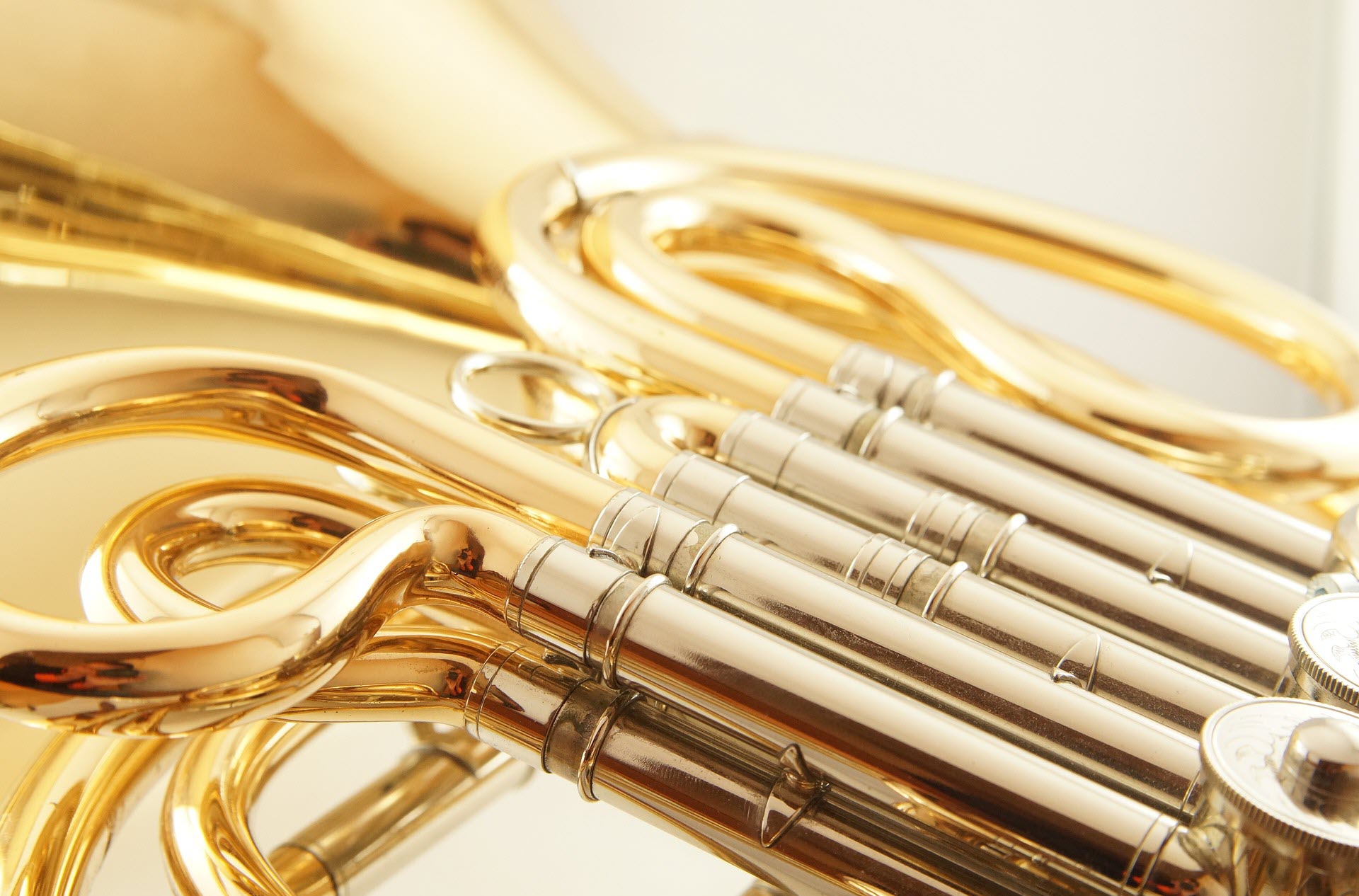
The French horn, also known as the horn, is a brass instrument that has a long and rich history dating back to the 17th century. The horn has undergone many changes and developments over the years, resulting in the instrument that we know and love today.
The earliest versions of the French horn were called “natural horns” or “hunting horns.” These instruments were made of wood or metal and were played by blowing into the wide end of the horn, producing a sound that was similar to that of a bugle. These horns were primarily used for hunting and signaling, and were typically played by members of the upper class or by professional horn players.
In the 17th century, the French horn began to evolve into the instrument that we know today. German instrument maker, Heinrich Stoelzel, added a fourth valve to the horn, allowing the player to play in different keys. This was a significant development as it allowed the horn to be played in more than one key, giving the instrument more versatility.
In the 19th century, another German instrument maker, Wilhelm Wieprecht, made further improvements to the horn. He added a fifth valve, which allowed the player to reach even higher notes. He also developed the double horn, which featured two sets of tubing, one for the key of F and one for the key of B-flat. This allowed the player to switch between the two keys easily, making the instrument even more versatile.
French horn players of the 19th century also began using a technique known as “stopping,” which involves the player covering the bell of the horn with their hand to produce a more mellow and muted sound. This technique is still used today and is an important aspect of French horn playing.
The 20th century saw further developments in the French horn, with the addition of a sixth valve and the development of the triple horn. The triple horn is similar to the double horn, but it also includes a third set of tubing for the key of high F. This allowed the player to reach even higher notes and made the instrument even more versatile. Today, the French horn is a staple in orchestras, bands, and brass ensembles around the world.
Since 2005, Singersroom has been the voice of R&B around the world. Connect with us via social media below.

